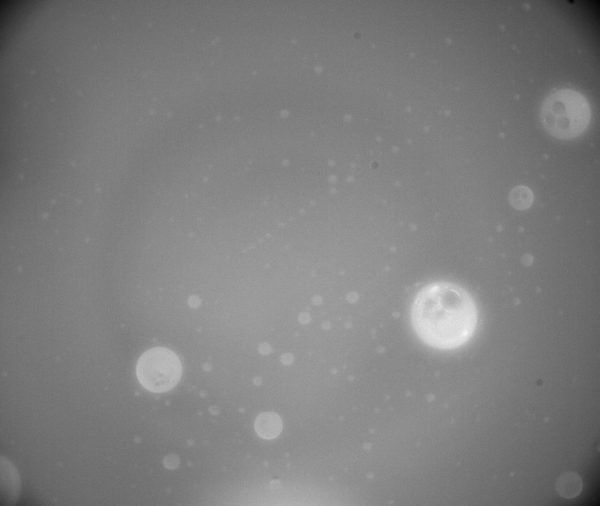Polyesters are present in everyday life, such as in plastics, but they are also relevant to origins of life. In this invited review (as part of the Early Career Presentation Award at the 2022 Biophysical Society of Japan Annual Meeting), the authors provide a historical overview of primitive polyester dehydration synthesis of alpha hydroxy acid monomers. This is followed by discussion of the state-of-the-art in microdroplet assembly via rehydration of polyester synthesis products, much of which was led by ELSI researchers. The authors end with unanswered questions related to polyester microdroplets as protocell models, challenging the field to work investigate.

Alpha hydroxy acids (AHAs) are simple monomers highly abundant in a number of prebiotically relevant environments, such as in meteorites or as UV radiation synthesis products, among others. These AHAs are not only likely abundant on early Earth, they also have a large number of potential chemical functionalities, which could help in the development of functions during the origin of life. Recent work has shown that AHAs can polymerize into polyesters through simple dehydration synthesis in “mild” heating conditions (i.e., <100°C). These polyesters can be composed of both homopolymers (starting reactant of a single, pure type of AHA), as well as heteropolymers (starting reactants of a mixture of more than one type of AHA). In fact, it’s possible to mix AHAs and amino acids, and multiple rounds of dehydration synthesis results in the emergence of depsipeptides (polymers containing both ester and amide bonds), and eventually in the sustained existence of peptides; this fact alone leads to the hypothesis that polyesters may have led to the emergence of the first peptides on Earth! However, before the emergence of depsipeptides and peptides, could polyesters themselves have participated in the origins of life in a different way? In particular, it is known that polymers of different compositions can function in various ways, such as through catalysis or self-assembly, and polyesters are indeed one type of polymer (in this case, they can be considered “non-biomolecular”, since they are not ubiquitous in biological systems like peptides).
As part of an invitation from the journal due to the Early Career Presentation Award (to co-author Tony Z. Jia, of the Earth-Life Science Institute (ELSI) at Tokyo Institute of Technology) at the 2022 Biophysical Society of Japan Annual Meeting, the authors first review the current literature regarding primitive polyester synthesis from AHA mixtures. One major study highlighted by the review, led by one of the review co-authors, Kuhan Chandru of the National University of Malaysia, showed that AHA mixtures containing up to five different monomers could be dried, resulting in synthesis of a wide variety of polyesters. Similarly, another highlighted study showed that increasing dehydration synthesis temperature resulted in longer polyester products, to a point, while monomer chirality did not appear to make any difference in polymer product length.
After polyesters are formed, it was discovered that rehydration of these products resulted in the assembly of membraneless microdroplets in solution. Thus, the authors next highlight two major studies characterising assembly of membraneless microdroplets from the polyester synthesis products. The first study, from 2019, showed the first demonstration of microdroplet assembly, and suggested that these microdroplets could have been relevant protocell models due to their ability to coalesce and segregate small organic molecules (dyes) and biopolymers (such as nucleic acids). The next study, from 2021, showed that small changes in polyester chemical composition (such as introduction of a cationic AHA), resulted in the ability for some polyester microdroplets to acquire the ability to segregate nucleic acids. These studies, all led by ELSI researchers over the last 5-10 years, form the basis of current studies related to polyester microdroplets as protocell models. Finally, the authors end with a number of unanswered questions regarding polyesters in origins of life research. For example, while the AHA chemical space is large, the currently tested AHAs with respect to primitive polyester synthesis and microdroplet assembly is quite small; more work is needed incorporating more diverse AHA compositions. This and other questions, such as the suitability of polyester-based components as materials-based panspermia seeds, are laid out to challenge the field to tackle these difficult questions in the near future.
“After highlighting the current state-of-the-art in primitive polyester synthesis and microdroplet assembly research, we realised that although there is already an impressive amount of work regarding this topic, there are many more unanswered questions than answered ones. We really hope to see more progress in this field in the next few years,” says Chandru.


| Journal | Biophysics and Physicobiology |
| Title of the paper | Recent progress in primitive polyester synthesis and membraneless microdroplet assembly |
| Authors | Tony Z. Jia1,2*, Kuhan Chandru3* |
| Affiliations | 1) Earth-Life Science Institute, Tokyo Institute of Technology, Meguro-ku, Tokyo 152-8550, Japan 2) Blue Marble Space Institute of Science, 3 Space Science Centre (ANGKASA), I 3) Space Science Centre (ANGKASA), Institute of Climate Change, National University of Malaysia, Bangi, Selangor Darul Ehsan 43650, Malaysia |
| DOI | 10.2142/biophysico.bppb-v20.0012 |
| Online published date | 4 March 2023 |
